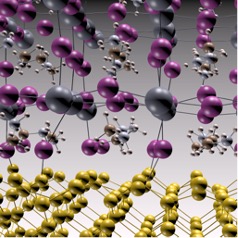1
Sustainable Materials for Photovoltaics and Energy Storage
2
Exascale Materials Science Simulations Through Extreme Scalable Libraries and Innovative Software

1. Sustainable Materials for Photovoltaics and Energy Storage
These initiatives focus on the computational design and evaluation of materials with enhanced sustainability profiles, specifically tailored for critical applications in energy production and storage.
Sustainable Materials for Photovoltaics
Goals
This task focuses on identifying and characterising Pb-free or Pb-less materials for perovskite solar cells (PSCS), addressing the quest for safer, more sustainable alternatives. Researchers will investigate replacements for lead, aiming to integrate these materials into various photovoltaic architectures—including single-junction cells and tandem devices with silicon or other perovskites.


Challenges
A key challenge lies in structural defects like grain boundaries, which reduce device efficiency. Using high-performance computing, we will model these imperfections from first principles and assess their impact on optoelectronic properties. Our approach combines Density Functional Theory with Many-Body Perturbation Theory (Yambo code) and includes large-scale simulations to study realistic systems. These efforts will guide the design of cleaner, high-performance materials for next-generation solar technologies.
People
Daniele Varsano (CNR) - PI
Giacomo Giorgi (Univ. Perugia CNR) – Task leader
Elisa Molinari (CNR) – WP leader
Costanza Borghesi (CNR) Hanami Postdoc
Nicola Spallanzani (CNR) EU partner
Maurizia Palummo (Univ. Tor vergata) EU partner
Koichi Yamashita (Yokohama City University, YCU) Japanese partner
Azusa Muraoka (Japan’s Women University, Tokyo) Japanese partner
Takahito Nakajima (RIKEN) Japanese partner
Giacomo Giorgi (Univ. Perugia CNR) – Task leader
Elisa Molinari (CNR) – WP leader
Costanza Borghesi (CNR) Hanami Postdoc
Nicola Spallanzani (CNR) EU partner
Maurizia Palummo (Univ. Tor vergata) EU partner
Koichi Yamashita (Yokohama City University, YCU) Japanese partner
Azusa Muraoka (Japan’s Women University, Tokyo) Japanese partner
Takahito Nakajima (RIKEN) Japanese partner
Electrochemistry and Battery Research
Context
Understanding the electrochemical interface (between electrolyte and electrode) with atomic detail and first-principles accuracy is a formidable task. However, recent advances in DFT techniques, both in computational efficiency and in methods to treat systems subject to external potentials, as well as the availability of massive computational resources, are making these simulations feasible.
Goals
This task intends to advance in this line, by developing and testing DFT methods that can effectively attack this problem in HPC facilities, and to apply these tools to advance in the search of new materials for more efficient, safer, faster charging and longer lasting devices for electrical energy storage (batteries and supercapacitors).


People
Pablo Ordejon (ICN2) Task Leader
Nils Wittemeier (ICN2) Hanami Postoc
Jose María Escartin (ICN2) EU Partner
Yoshitaka Tateyama (NIMS Tsukuba) Japanese Partner
Minoru Otani (University Tsukuba) Japanese Partner
Deborah Prezzi (CNR-Nano, Modena) EU Partner
Stefan Blugel (FZ Jülich) EU Partner
Nils Wittemeier (ICN2) Hanami Postoc
Jose María Escartin (ICN2) EU Partner
Yoshitaka Tateyama (NIMS Tsukuba) Japanese Partner
Minoru Otani (University Tsukuba) Japanese Partner
Deborah Prezzi (CNR-Nano, Modena) EU Partner
Stefan Blugel (FZ Jülich) EU Partner
Hydrogen Storage
Goals
The research on hydrogen storage in the project will focus on understanding hydrogen and its chemistry in systems like superconducting hydrides and hydrogen-bearing clathrate hydrates. The goal is to create accurate potential energy surfaces that maintain quantum accuracy in Monte Carlo simulations, which can then be used for further calculations involving nuclear quantum effects.
Challenges
This will enable predictive calculations of hydrogen-rich compounds, helping design high-temperature superconductors and hydrogen storage materials. Atomistic potentials will be derived using machine learning applied to data generated by the QMC TurboRVB code, building on the workflow developed at HANAMI.
People
Michele Casula (CNRS) Task Leader
Kosuke Nakano (NIMS) Japanese Partner
Marco Cherubini (CNRS) HANAMI Postdoc
Abhishelk Raghav (CNRS) HANAMI Postdoc
Kosuke Nakano (NIMS) Japanese Partner
Marco Cherubini (CNRS) HANAMI Postdoc
Abhishelk Raghav (CNRS) HANAMI Postdoc
2. Exascale Materials Science Simulations Through Extreme Scalable Libraries and Innovative Software
Collaborators will co-develop highly scalable, cutting-edge software tools and computational libraries designed to support future frontier applications in materials science.
By integrating scientific expertise, computational innovation, and international cooperation, this work package aims to make a tangible contribution to the transition toward sustainable energy systems.
Numerical Linear Algebra Framework for Materials Science
Context
An efficient and parallel framework that combines large-scale numerical libraries with Materials Science codes is key to advancing research on new materials. This will speed up material discovery and help develop materials with specific properties.
Goals
The HANAMI project aims to create a system that ensures the most efficient parallel execution at both the numerical libraries and domain software levels. This is especially important for energy-related materials, as faster discovery can help address climate change by improving clean energy production and storage, making a significant impact on society.


People
Edoardo Di Napoli (FZJ) WP Leader
Luigi Genovese (CEA)
Alessandro Pecchia (CNR)
Toshiyuki Imamura (RIKEN R-CCS) Japanese Partner
Kengo Nagajima (Univ. Tokyo) Japanese Partner
William Dawson (RIKEN R-CCS) Japanese Partner
Tetsuya Sakurai (Tsukuba Univ.) Japanese Partner
Clement Richefort (FZJ) HANAMI Postdoc
Xinzhe Wu (FZJ) Research Scientist
Luigi Genovese (CEA)
Alessandro Pecchia (CNR)
Toshiyuki Imamura (RIKEN R-CCS) Japanese Partner
Kengo Nagajima (Univ. Tokyo) Japanese Partner
William Dawson (RIKEN R-CCS) Japanese Partner
Tetsuya Sakurai (Tsukuba Univ.) Japanese Partner
Clement Richefort (FZJ) HANAMI Postdoc
Xinzhe Wu (FZJ) Research Scientist
Non Equilibrium Charge Dynamics in 2D Materials
Context
The non-equilibrium dynamics of charge carriers in 2D materials, like TMDCSs, are key to their potential. Two-dimensional nanostructures are emerging as promising materials for photovoltaics, thermoelectrics, energy storage, light-emitting devices, and high-speed transistors.
Goals
To address the global climate challenge, both experimental and theoretical efforts are needed. Finding efficient and abundant photoconversion materials could accelerate the transition to green energy. Transition metal dichalcogenides are relatively abundant and could lead to highly efficient devices.
People
Alessandro Pecchia (CNR) Task Leader
Takahito Nagajima (RIKEN R-CCS) Japanese Partner
Tetsuya Sakurai (Univ. Tsukuba) Japanese Partner
Taisuke Ozaki (Univ. Tokyo) Japanese Partner
Edoardo Di Napoli (FZJ)
Luigi Genovese (CEA)
Takahito Nagajima (RIKEN R-CCS) Japanese Partner
Tetsuya Sakurai (Univ. Tsukuba) Japanese Partner
Taisuke Ozaki (Univ. Tokyo) Japanese Partner
Edoardo Di Napoli (FZJ)
Luigi Genovese (CEA)
Enhancing Materials Science Scalability Through Innovative Block Sparse Libraries
People
Luigi Genovese (CEA) Task Leader
Takahito Nakajima (RIKEN R-CCS) Japanese Partner
Sergeij Manzhos (Tokyo Tech) Japanese Partner
Alessandro Pecchia (CNR)
Edoardo Di Napoli (FZJ)
Takahito Nakajima (RIKEN R-CCS) Japanese Partner
Sergeij Manzhos (Tokyo Tech) Japanese Partner
Alessandro Pecchia (CNR)
Edoardo Di Napoli (FZJ)








